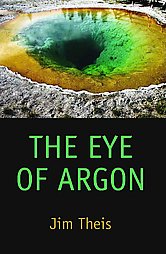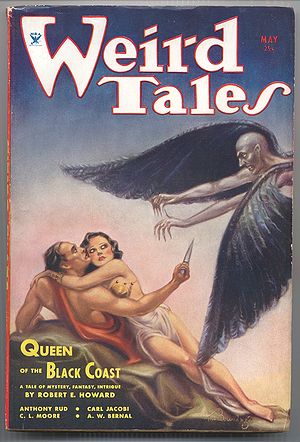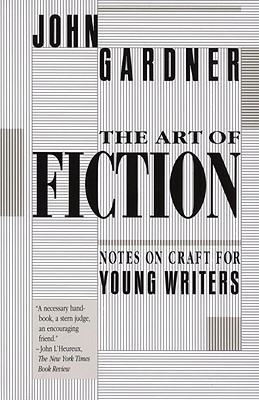Teaching Fantasy II: In Which I Knowingly Assign the Worst Short Story in the History of Sword and Sorcery
 It was for his own good, honest.
It was for his own good, honest.
My student said, “It’s time I learned to proofread. Can we do that next?”
I nearly fell off my chair. He was right, of course, but it’s not a skill students usually ask to work on. “Sure. I’ll see what kinds of exercises I can find in my files at home…”
“No exercises! No fake documents. Please, don’t ask me to proofread something whose only purpose on this earth is to be proofread.” A very reasonable objection. “How about we proofread one of your manuscripts?”
Uh oh.
Now, there are teachers out there who share their rough drafts with their students. There are even teachers who produce their first drafts alongside their students, right there in the classroom. The argument in favor of doing this is that it can demystify the writing process, demonstrate that revision really is worth doing, and build classroom rapport. All good things, but the downside is that what the student gets out of the experience is often about the teacher, rather than about the student’s own development as a writer or about the skills the teacher thinks s/he is demonstrating.
It’s been a while since I worked in the classroom, but even one on one, the pitfalls of this practice remain. Moreover, my student was going to need a document with a lot of errors, preferably a lot of very basic errors. My rough drafts can be pretty drafty, but not drafty enough for that. I wanted to find a story that would be of high interest to a fantasy-reading, gaming-obsessed, fourteen-year-old boy. Something with adventure, magic, violence, and truly abysmal grammar.
Some of you will be shouting at your computer screens now, something along the lines of, “You assigned ‘The Eye of Argon’ to some innocent, unsuspecting student?!”
Yes, reader, I did.
For those of you unfamiliar with “The Eye of Argon,” it first appeared in a fanzine in 1970, in the days of mimeograph, yet its awfulness was so overwhelming that it took SF fandom by storm. It remains, in its twisted way, a classic.
 To this day, a standard feature of fan conventions is a party game that requires participants to take turns reading this story until the errors crack them up, with highest honors going to the player who can read longest before the errors fell them. It’s a rare and jaded reader who can make it through half a page without laughing. The errors are numerous, various, glorious. There’s the female character with the “lithe, opaque nose,” the “many fauceted scarlet emerald,” and a scene in which the protagonist pulls his sword out of what the author probably intended to be a loincloth — Robert E. Howard’s stories are full of loincloths, after all — but the word that landed on the page is “g-string”. The author, a fellow named Jim Theis, was so mortified at the nature of his fame, he gave up writing fiction altogether. Good riddance, you say? We’ll come back to Jim Theis later.
To this day, a standard feature of fan conventions is a party game that requires participants to take turns reading this story until the errors crack them up, with highest honors going to the player who can read longest before the errors fell them. It’s a rare and jaded reader who can make it through half a page without laughing. The errors are numerous, various, glorious. There’s the female character with the “lithe, opaque nose,” the “many fauceted scarlet emerald,” and a scene in which the protagonist pulls his sword out of what the author probably intended to be a loincloth — Robert E. Howard’s stories are full of loincloths, after all — but the word that landed on the page is “g-string”. The author, a fellow named Jim Theis, was so mortified at the nature of his fame, he gave up writing fiction altogether. Good riddance, you say? We’ll come back to Jim Theis later.
I set my student up with an online copy of the story, the Wikipedia entry on it for context, and an assignment to mark up the first five pages, circling every error he could detect.
As I drove home from teaching, it occurred to me that if my student’s parents read the story without knowing what I’d assigned him to do with it, I might well lose that client family. I thought of all the brave teachers who’ve risked their jobs standing up for censored works of great literature, and considered that my destiny was to be the person who lost a tutoring gig over “The Eye of Argon.” I had to pull over by the side of the road until I could stop laughing.
What actually happened next was entirely unexpected.
My student’s family is bilingual. I’m in awe of truly bilingual people, but the price for that linguistic superpower is usually a narrow English vocabulary. The kid had marked every word that he thought was used incorrectly, every word he thought might not really be a word, and every word he thought was misspelled, figuring he’d make time to check the dictionary later.
It is possible to overestimate the awfulness of “The Eye of Argon.” Who would have guessed it?
Okay, the story still flunks Mark Twain’s lightning bug test. Resoundingly. Repeatedly. “The difference between the almost right word and the right word is really a large matter — ’tis the difference between the lightning-bug and the lightning,” says Twain. Yet the words are almost right. Some of them are quite impressive words for a sixteen-year-old to attempt at all — Jim Theis was sixteen years old when he wrote “The Eye of Argon” — and in most cases it’s clear he knows at least one legitimate definition of the word he’s used inappropriately. Theis probably did pretty well on his vocabulary quizzes.
We ended up spending both of our proofreading sessions leafing through the dictionary, leapfrogging my student over Jim Theis, from not recognizing all those real words to knowing how to use them idiomatically. We never even got to the grammatical errors. Really, who could spend more than two weeks immersed in the misadventures of Grignr the Ecordian?
The tragedy of Jim Theis is that he got just enough success to be held to professional standards when he was simply too young to meet them. Another sixteen-year-old might have more sentence-level polish or the makings of a more graceful prose style, but no sixteen-year-old can be expected to have a mature relationship with the authors who influence him; the biggest problem Theis had that couldn’t have been fixed by a modern word processor’s spell check function is actually his immature relationship with Robert E. Howard’s influence.
Had Theis been a student of mine and handed me “The Eye of Argon” as an assignment, I would have been thrilled. Here’s a partial list of the virtues the story displays that cannot be counted on in stories by high school students:
*You can tell what the author probably intended to say in almost every sentence.
* The story has characters.
* Something happens.
* Several somethings, even, with some detectable instances of cause and effect.
* The author has a unified idea of what he’s trying to accomplish, and he sticks with it from start to finish.
* The story has a beginning, a middle, and (in some versions of the text) an end.
* You can tell what tradition the author is writing in, and that his influences are deliberately embraced.
* It’s a long enough story to have required many days of sustained effort.
* You can tell that the author truly does care about what he’s writing.
Every one of those virtues could be followed by a but. But!
 In some alternate universe, Jim Theis showed this story to a mentor, instead of submitting it for publication. That quantum mentor gave him forthright criticism, sent him off to do all the exercises in John Gardner’s The Art of Fiction, and gave him the sword and sorcery equivalent of Gardner’s advice to read all of Faulkner and then all of Hemingway to get the Faulkner out of his system. (Which of our own luminaries would we plug into that mad lib? Clearly Theis had read plenty of Howard — who would be our most suitable Hemingway to Howard’s Faulkner?) In our alternate universe, Theis was advised to write his million words of crap before expecting to hit his stride, to give himself ten years of practice in pursuit of mastery. That’s more or less the advice he’d get now, from most of the mentorly-minded pros in our field.
In some alternate universe, Jim Theis showed this story to a mentor, instead of submitting it for publication. That quantum mentor gave him forthright criticism, sent him off to do all the exercises in John Gardner’s The Art of Fiction, and gave him the sword and sorcery equivalent of Gardner’s advice to read all of Faulkner and then all of Hemingway to get the Faulkner out of his system. (Which of our own luminaries would we plug into that mad lib? Clearly Theis had read plenty of Howard — who would be our most suitable Hemingway to Howard’s Faulkner?) In our alternate universe, Theis was advised to write his million words of crap before expecting to hit his stride, to give himself ten years of practice in pursuit of mastery. That’s more or less the advice he’d get now, from most of the mentorly-minded pros in our field.
Here in our universe, you can find “The Eye of Argon” in a 2006 trade paperback edition from Wildside Press, that great curatorial institution of the pulp tradition, alongside collections of August Derleth and Lord Dunsany. Anybody who’s read slush or taught writing has seen egregious fiction, but you’ve got to have something special going (or going wrong) for a short specimen of your juvenilia to warrant its own trade paperback in such illustrious company nearly 40 years after first seeing print.
Sarah Avery’s short story “The War of the Wheat Berry Year” appeared in the last print issue of Black Gate. A related novella, “The Imlen Bastard,” is slated to appear in BG‘s new online incarnation. Her contemporary fantasy novella collection, Tales from Rugosa Coven, follows the adventures of some very modern Pagans in a supernatural version of New Jersey even weirder than the one you think you know. You can keep up with her at her website, sarahavery.com, and follow her on Twitter.
Fritz Leiber perhaps? Or Ursula K. LeGuin? Poul Anderson? I had to check the Wikipedia for the timing, to wonder what to recommend. J.R.R. Tolkien might also have helped, or Lord Dunsany, except that while they were different kinds of sonorous writing, they were still in the high style.
At least you didn’t have him proofread Atlanta Nights.
Great post. Great idea for an exercise, too. A few thoughts:
1) I taught a college-level Creative Writing course once (and I agree with everything you say about young writers, and your assessment of Theis’ situation). I think the question of whether to share one’s own writing with a group of students is complex, and depends on a lot of issues — the age of the students, why they’re taking the course, and a lot of other variables. Basically, whether it’d encourage them, or cause them to freeze up.
2) I’d have to say I have wildly different experiences with bilinguals than you do. I don’t know if this is a a function of Montréal’s culture — so many people I know are bilingual from birth, or at least from when they first started speaking, with rich vocabularies in both languages.
3) I love what you have to say about Theis. I’ve never understood why mocking a high-schooler’s story from some fanzine was considered appropriate.
4) In re: Hemingway and Faulkner — I’d actually think that Howard fits the Hemingway mode much more than the Faulkner. Maybe Dunsany as Faulkner? Or E.R. Eddison?
I like this article.
I think that kid you’re teaching won’t ever forget you.
The Eye of Argon must have something going for it, if it’s still talked about after all these decades.
Excellent post.
@Mary, I did consider Atlanta Nights, but the content (such as it is) is less high-interest for teenage boys. Now that you suggest it, I’m in danger now of actually reading Atlanta Nights in search of teaching exercises.
Le Guin’s early fantasy tends toward the high style, but her later stuff might be pared down enough to be good sentence-level medicine.
@Matthew, Howard has a Hemingwayesque ethos, but his prose style is much more ornamental, with odd baroque moments. Leigh Brackett’s sword-and-planet stories might come as close as our genre can to Hemingway’s terse, understated style. Dunsany’s too much in the high style–he does smoothly and ironically several things Howard did heavily and in earnest. That’s a useful contrast, but not the kind of contrast John Gardner’s getting at between excess of ornament and phobia of ornament.
I think I read a tiny bit of Eddison in my teens, but remember none of it. Must go back and rectify that.
My bilingual students are mostly from immigrant families, with parents whose cradle languages are Chinese, Russian, Gujarati, and Marathi. Maybe it’s that even the Indo-European languages are distant enough linguistic cousins to offer very few cognates and loan words.
@ CSE I won’t forget this student, either. He’s really made me stretch as a teacher. I love it when they do that.
There are people who’ve read Atlanta Nights all the way through. . . or so I’ve been assured. (I can’t even read my own chapter.)
[…] Black Gate (Sarah Avery) on Teaching Fantasy II: In Which I Knowingly Assign the Worst Short Story in the History of Sword and S…. […]
[…] Sarah Avery imparts her wisdom regarding using the famously bad story ‘The Eye of Argon’… […]
[…] my own students’ drafts. To me, Eragon feels only slightly more polished and promising than that other famous adolescent hit, “The Eye of Argon.” My comments might have helped Paolini improve the story or its execution, but it’s hard to […]
[…] So, thanks to Michael Gurian’s book The Minds of Boys, I ended up kicking a ball around the basement with a seventh grader while he talked his way through composing and revising an epic tale of dragons, good versus evil, and wizards gone wrong. The project was kind of derivative, but hey, seventh grade. I was far better at asking questions to help him develop his plot and characters than at kicking the ball, yet my willingness to engage in something reminiscent of soccer was a big part of why I got paid to do that teaching. My student’s parents were desperate to get their son to find something about writing that he did not hate. They had tried everything else. Kicking a ball is not exactly about writing, but by the time that tutoring gig wound down, the kid produced a fairly polished final draft that weighed in at 12,000 words and was considerably better than The Eye of Argon. […]
[…] Chuck Wendig has another entry in his writing advice. “25 Ways to Make Exposition Your Bitch” has a few things I had never thought of. I hope he teaches writing somewhere, his “voice” could be a welcome antidote to MFA-itis. Sarah Avery is a writing teacher, and explains why she assigns the worst story “ever written” to her students. […]